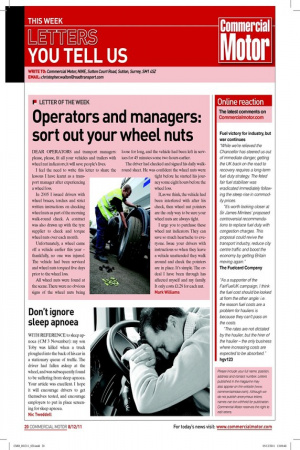LETTER OF THE WEEK
Page 14

If you've noticed an error in this article please click here to report it so we can fix it.
Operators and managers: sort out your wheel nuts
DEAR OPERATORS and transport managers: please, please, it all your vehicles and trailers with wheel nut indicators; it will save people’s lives.
I feel the need to write this letter to share the lessons I have learnt as a transport manager after experiencing a wheel loss.
In 2005 I issued drivers with wheel braces, torches and strict written instructions on checking wheel nuts as part of the morning walk-round check. A contract was also drawn up with the tyre supplier to check and torque wheel nuts over each month.
Unfortunately, a wheel came off a vehicle earlier this year – thankfully, no one was injured. The vehicle had been serviced and wheel nuts torqued ive days prior to the wheel loss.
All wheel nuts were found at the scene. There were no obvious signs of the wheel nuts being loose for long, and the vehicle had been left in services for 45 minutes some two hours earlier.
The driver had checked and signed his daily walkround sheet. He was conident the wheel nuts were tight before he started his journey some eight hours before the wheel loss.
If, as we think, the vehicle had been interfered with after his check, then wheel nut pointers are the only way to be sure your wheel nuts are always tight.
I urge you to purchase these wheel nut indicators. They can save so much heartache to everyone. Issue your drivers with instructions so when they leave a vehicle unattended they walk around and check the pointers are in place. It’s simple. The ordeal I have been through has affected myself and my family. It only costs £1.29 for each nut. Mark Williams










































